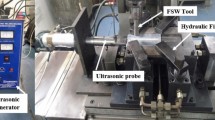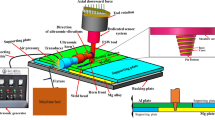Abstract
Al/Cu dissimilar joint has been widely produced by using friction stir welding (FSW), but the weld quality remains limited. A recently developed ultrasonic vibration-assisted FSW (UVaFSW) technology has shown potential of enhancing the material flow and mechanical properties of Al/Cu joint. In this paper, a systematic study is presented to investigate the effect of ultrasonic energy on FSW Al/Cu joints with an optimized tool shoulder diameter of 16 mm and welding speed of 60 mm/min. It is found that the thermal effect of ultrasonic on the FSW process could be deemed negligible, which is distinguishing with other transmission method of ultrasonic energy. Correspondingly, the mechanical effect of ultrasonic is evident because of the dramatically decreased welding loads, the more intense intermixing between Al and Cu, and the more uniformly distributed micro-hardness in the stirring zone of UVaFSW Al/Cu joints. Moreover, the ultrasonic energy reveals a positive influence on the weld quality of Al/Cu joint; the maximum tensile strength by UVaFSW is achieved at the rotation speed of 500 rpm; and the value reaches 162.8 MPa, which improves by 60.7% compared with that by FSW. It is elucidated that the ultrasonic vibration effectively reduces the activation energy and flow stress of the material, stimulates stable plastic deformation in the vicinity of the tool, and is beneficial for the homogeneous of FSW Al/Cu joint.
















Similar content being viewed by others
References
Nandan R, DebRoy T, Bhadeshia HKDH (2008) Recent advances in friction-stir welding – process, weldment structure and properties. Prog Mater Sci 53(6):980–1023
Imaizumi S (1996) Welding of aluminum to dissimilar metals. Weld Int 10(8):593–604
Lee SJ, Nakamura H, Kawahito Y, Katayama S (2014) Effect of welding speed on microstructural and mechanical properties of laser lap weld joints in dissimilar Al and Cu sheets. Sci Technol Weld Joi 19(2):111–118
Mai TA, Spowage AC (2004) Characterization of dissimilar joints in laser welding of steel-kovar, copper-steel and copper-aluminum. Mat Sci Eng A 374(1–2):224–233
Zhou L, Li ZY, Song XG, Tan CW, He ZZ, Huang YX, Feng JC (2017) Influence of laser offset on laser welding-brazing of Al/brass dissimilar alloys. J Alloy Compd 717:78–92
Mvola B, Kah P, Martikainen J, Suoranta R (2014) State-of-the-art of advanced gas metal arc welding processes: dissimilar metal welding. P I Mech Eng B-J Eng 229(10):1694–1710
DebRoy T, Bhadeshia HKDH (2010) Friction stir welding of dissimilar alloys – a perspective. Sci Technol Weld Joi 15(4):266–270
Ouyang JH, Kovacevic R (2002) Material flow and microstructure in the friction stir butt welds of the same and dissimilar aluminum alloys. J Mater Eng Perform 11(1):51–63
Wan L, Huang Y (2018) Friction stir welding of dissimilar aluminum alloys and steel: a review. Int J Adv Manuf Tech 99(1–4):1178–1811
Murr LE, Li Y, Flores RD, Trillo EA, McClure JC (1998) Intercalation vortices and related microstructural features in the friction-stir welding of dissimilar metals. Mater Res Innov 2(3):150–163
Ouyang J, Yarrapareddy E, Kovacevic R (2006) Microstructural evolution in the friction stir welded 6061 aluminum alloy (T6-temper condition) to copper. J Mater Process Tech 172(1):110–122
Liu HJ, Shen JJ, Zhou L, Zhao YQ, Liu C, Kuang LY (2011) Microstructural characterization and mechanical properties of friction stir welded joints of aluminum alloy to copper. Sci Technol Weld Joi 16(1):92–99
Xue P, Xiao BL, Ma ZY (2015) Effect of interfacial microstructure evolution on mechanical properties and fracture behavior of friction stir-welded Al-Cu joints. Metall Mater Trans A 46(7):3091–3103
Medhi T, Yadava MK, Roy BS, Saha SC (2019) An experimental investigation on implications of traverse speed in joining of dissimilar Al–Cu by friction stir welding. Int J Adv Manuf Tech 104(1–4):1461–1471
Al-Roubaiy AO, Nabat SM, Batako ADL (2014) Experimental and theoretical analysis of friction stir welding of Al–Cu joints. Int J Adv Manuf Tech 71(9–12):1631–1642
Galvão I, Oliveira JC, Loureiro A, Rodrigues DM (2012) Formation and distribution of brittle structures in friction stir welding of aluminum and copper: influence of shoulder geometry. Intermetallics 22:122–128
Akinlabi ET (2012) Effect of shoulder size on weld properties of dissimilar metal friction stir welds. J Mater Eng Perform 12(7):1514–1519
Mehta KP, Badheka VJ (2017) Influence of tool pin design on properties of dissimilar copper to aluminum friction stir welding. T Nonferr Metal Soc 27(1):36–54
Xue P, Ni DR, Wang D, Xiao BL, Ma ZY (2011) Effect of friction stir welding parameters on the microstructure and mechanical properties of the dissimilar Al-Cu joints. Mat Sci Eng A 528(13–14):4683–4689
Xue P, Xiao BL, Ni DR, Ma ZY (2011) Enhanced mechanical properties of friction stir welded dissimilar Al-Cu joint by intermetallic compounds. Mat Sci Eng A 527(21–22):5723–5727
Galvão I, Loureiro A, Verdera D, Gesto D, Rodrigues DM (2012) Influence of tool offsetting on the structure and morphology of dissimilar aluminum to copper friction-stir welds. Metall Mater Trans A 43(13):5096–5510
Esmaeili A, Rahani HRZ, Sharbati M, Givi MKB, Shamanian M (2011) The role of rotation speed on intermetallic compounds formation and mechanical behavior of friction stir welded brass/aluminum 1050 couple. Intermetallics 19(11):1711–1719
Akinlabi ET, Andrews A, Akinlabi S (2014) Effects of processing parameters on corrosion properties of dissimilar friction stir welds of aluminum and copper. T Nonferr Metal Soc 24(5):1323–1330
Galvão I, Oliveira JC, Loureiro A, Rodrigues DM (2011) Formation and distribution of brittle structures in friction stir welding of aluminum and copper: influence of process parameters. Sci Technol Weld Joi 16(8):681–689
Padhy GK, Wu CS, Gao S (2015) Auxiliary energy assisted friction stir welding – status review. Sci Technol Weld Joi 20(8):631–649
Safi SV, Amirabadi H, Givi MKB, Safi SM (2016) The effect of preheating on mechanical properties of friction stir welded dissimilar joints of pure copper and AA7075 aluminum alloy sheets. Int J Adv Manuf Tech 84(9–12):2401–2411
Yaduwanshi DK, Bag S, Pal S (2016) Numerical modeling and experimental investigation on plasma-assisted hybrid friction stir welding of dissimilar materials. Mater Design 92:166–183
Mehta KP, Badheka VJ (2017) Hybrid approaches of assisted heating and cooling for friction stir welding of copper to aluminum joints. J Mater Process Tech 239:336–345
Zhang J, Shen Y, Yao X, Xu H, Li B (2014) Investigation on dissimilar underwater friction stir lap welding of 6061-T6 aluminum alloy to pure copper. Mater Design 64:74–80
Liu XC, Wu CS, Padhy GK (2015) Improved weld macrosection, microstructure and mechanical properties of 2024Al-T4 butt joints in ultrasonic vibration enhanced friction stir welding. Sci Technol Weld Joi 20(4):345–352
Zhong YB, Wu CS, Padhy GK (2017) Effect of ultrasonic vibration on welding load, temperature and material flow in friction stir welding. J Mater Process Tech 239:273–283
Hu Y, Liu H, Fujii H (2019) Improving the mechanical properties of 2219-T6 aluminum alloy joints by ultrasonic vibrations during friction stir welding. J Mater Process Tech 271:75–84
Ding W, Wu C (2019) Effect of ultrasonic vibration exerted at the tool on friction stir welding process and joint quality. J Manuf Process 42:192–201
Lv X, Wu C, Yang C, Padhy GK (2018) Weld microstructure and mechanical properties in ultrasonic enhanced friction stir welding of Al alloy to mg alloy. J Mater Process Tech 254:145–157
Ji S, Meng X, Liu Z, Huang R, Li Z (2017) Dissimilar friction stir welding of 6061 aluminum alloy and AZ31 magnesium alloy assisted with ultrasonic. Mater Lett 201:173–176
Strass B, Wagner G, Eifler D (2014) Realization of Al/mg-hybrid-joints by ultrasound supported friction stir welding. Mater Sci Forum 783-786:1814–1819
Thomä M, Wagner G, Straß B, Wolter B, Benfer S, Fürbeth W (2018) Ultrasound enhanced friction stir welding of aluminum and steel: process and properties of EN aw 6061/DC04-joints. J Mater Sci Technol 34(1):163–172
Muhammad NA, Wu CS (2019) Ultrasonic vibration assisted friction stir welding of aluminum alloys and pure copper. J Manuf Process 39:114–127
Muhammad NA, Wu CS, Tian W (2019) Effect of ultrasonic vibration on the intermetallic compound layer formation in Al/Cu friction stir weld joints. J Alloy Compd 785:512–522
Kumar S, Ding W, Sun Z, Wu CS (2018) Analysis of the dynamic performance of a complex ultrasonic horn for application in friction stir welding. Int J Adv Manuf Tech 97:1269–1284
Shi L, Wu CS, Gao S (2018) Analysis of welding load reduction in ultrasonic vibration-enhanced friction stir welding. Int J Adv Manuf Tech 99(1–4):373–385
Zhao W, Wu C (2019) Constitutive equation including acoustic stress work and plastic strain for modeling ultrasonic vibration assisted friction stir welding process. Int J Mach Tool Manu 145:103434
Funding
The authors acknowledge the financial support from the Key R&D Program of Shandong Province in China (Grant No. 2018GGX103001). Hao Su is grateful to the financial support of the Fundamental Research Funds of Shandong University (Grant No. 2019GN003).
Author information
Authors and Affiliations
Corresponding author
Ethics declarations
Conflict of interest
The authors declare that they have no conflict of interest.
Additional information
Publisher’s note
Springer Nature remains neutral with regard to jurisdictional claims in published maps and institutional affiliations.
Rights and permissions
About this article
Cite this article
Tian, W., Su, H. & Wu, C. Effect of ultrasonic vibration on thermal and material flow behavior, microstructure and mechanical properties of friction stir welded Al/Cu joints. Int J Adv Manuf Technol 107, 59–71 (2020). https://doi.org/10.1007/s00170-020-05019-0
Received:
Accepted:
Published:
Issue Date:
DOI: https://doi.org/10.1007/s00170-020-05019-0




